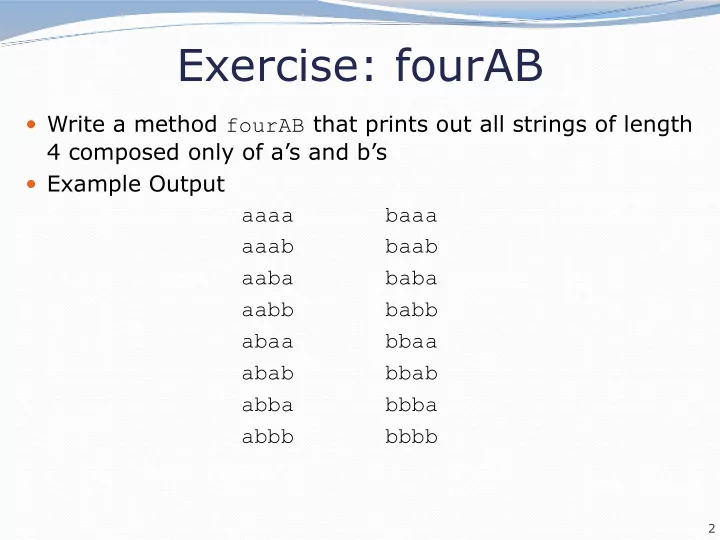

Exercise: fourAB Write a method fourAB that prints out all strings of length 4 composed only of a’s and b’s Example Output aaaa baaa aaab baab aaba baba aabb babb abaa bbaa abab bbab abba bbba abbb bbbb 2
Decision Tree a b … aa ab … aaa aab aaaa aabb aaab aaba 3
Exercise: Dice rolls Write a method diceRoll that accepts an integer parameter representing a number of 6-sided dice to roll, and output all possible arrangements of values that could appear on the dice. diceRoll(2); diceRoll(3); [1, 1] [3, 1] [5, 1] [1, 1, 1] [1, 2] [3, 2] [5, 2] [1, 1, 2] [1, 3] [3, 3] [5, 3] [1, 1, 3] [1, 4] [3, 4] [5, 4] [1, 1, 4] [1, 5] [3, 5] [5, 5] [1, 1, 5] [1, 6] [3, 6] [5, 6] [1, 1, 6] [2, 1] [4, 1] [6, 1] [1, 2, 1] [2, 2] [4, 2] [6, 2] [1, 2, 2] [2, 3] [4, 3] [6, 3] ... [2, 4] [4, 4] [6, 4] [6, 6, 4] [2, 5] [4, 5] [6, 5] [6, 6, 5] [2, 6] [4, 6] [6, 6] [6, 6, 6] 4
A decision tree chosen available - 4 dice 2 3 dice 1 3 dice ... 1, 1 2 dice 1, 2 2 dice 1, 3 2 dice 1, 4 2 dice ... ... ... 1, 1, 1 1 die 1, 1, 2 1 die 1, 1, 3 1 die 1, 4, 1 1 die ... ... ... ... 1, 1, 1, 1 1, 1, 1, 2 1, 1, 3, 1 1, 1, 3, 2 6
Backtracking backtracking : Finding solution(s) by trying partial solutions and then abandoning them if they are not suitable. a "brute force" algorithmic technique (tries all paths) often implemented recursively Applications: producing all permutations of a set of values parsing languages games: anagrams, crosswords, word jumbles, 8 queens combinatorics and logic programming 10
Backtracking strategies When solving a backtracking problem, ask these questions: What are the "choices" in this problem? What is the "base case"? (How do I know when I'm out of choices?) How do I "make" a choice? Do I need to create additional variables to remember my choices? Do I need to modify the values of existing variables? How do I explore the rest of the choices? Do I need to remove the made choice from the list of choices? Once I'm done exploring, what should I do? How do I "un-make" a choice? 12
Exercise: Dice roll sum Write a method diceSum similar to diceRoll , but it also accepts a desired sum and prints only arrangements that add up to exactly that sum. diceSum(2, 7); diceSum(3, 7); [1, 6] [1, 1, 5] [2, 5] [1, 2, 4] [3, 4] [1, 3, 3] [4, 3] [1, 4, 2] [5, 2] [1, 5, 1] [6, 1] [2, 1, 4] [2, 2, 3] [2, 3, 2] [2, 4, 1] [3, 1, 3] [3, 2, 2] [3, 3, 1] [4, 1, 2] [4, 2, 1] [5, 1, 1] 13
Consider all paths? chosen available desired sum - 3 dice 5 1 2 dice 2 2 dice 3 2 dice 4 2 dice 5 2 dice 6 2 dice 1, 1 1 die 1, 2 1 die 1, 3 1 die 1, 4 1 die 1, 5 1 die 1, 6 1 die 1, 1, 1 1, 1, 2 1, 1, 3 1, 1, 4 1, 1, 5 1, 1, 6 1, 6, 1 1, 6, 2 ... 14
Optimizations We need not visit every branch of the decision tree. Some branches are clearly not going to lead to success. We can preemptively stop, or prune , these branches. Inefficiencies in our dice sum algorithm: Sometimes the current sum is already too high. (Even rolling 1 for all remaining dice would exceed the sum.) Sometimes the current sum is already too low. (Even rolling 6 for all remaining dice would not reach the sum.) When finished, the code must compute the sum every time. (1+1+1 = ..., 1+1+2 = ..., 1+1+3 = ..., 1+1+4 = ..., ...) 15
New decision tree chosen available desired sum - 3 dice 5 1 2 dice 2 2 dice 3 2 dice 4 2 dice 5 2 dice 6 2 dice 1, 1 1 die 1, 2 1 die 1, 3 1 die 1, 4 1 die 1, 5 1 die 1, 6 1 die 1, 1, 1 1, 1, 2 1, 1, 3 1, 1, 4 1, 1, 5 1, 1, 6 1, 6, 1 1, 6, 2 ... 16
Recommend
More recommend